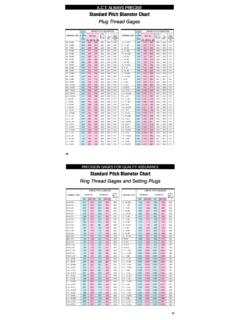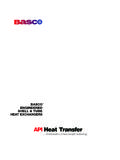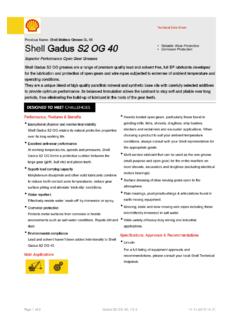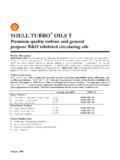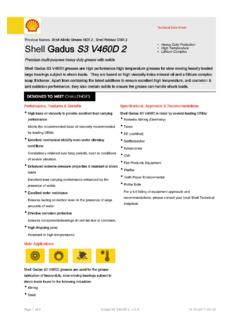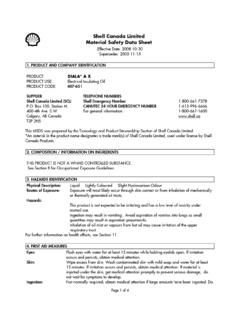Transcription of Shell Canada Limited
1 DROMUS* B407-776 Revision Number: 6 Shell Canada LimitedMaterial Safety Data SheetEffective Date: 2002-11-19 Supersedes: 2002-10-04 Class D2B Other Toxic Effects - Eye Irritant1. PRODUCT AND COMPANY IDENTIFICATION PRODUCT:DROMUS* B SYNONYMS:EMULSIFIABLE CUTTING OIL AND COOLANTIn use, this oil is mixed with water. This combination has the potential to encourage the growth of bacteria, which may cause health effects. Use ofa biocide in the fluid or monitoring of the working fluid on a regular basis is recommended to avoid the possibility of exposure to bacterial contamination. PRODUCT USE:Metalworking Oil MSDS Number: 407-776 MANUFACTURER TELEPHONE NUMBERS Shell Canada Limited Shell Emergency Number1-800-661-7378 Box 100, Station M CANUTEC 24 HOUR EMERGENCY NUMBER613-996-6666 400-4th Ave.
2 Calgary, AB Canada For general information:1-800-661-1600 T2P 2H5 For MSDS information: (From 7:30 to 4:30 Mountain Time)403-691-3982 403-691-2220 This MSDS was prepared by the Toxicology and Product Stewardship Section of Shell Canada Limited . *An asterisk in the product name designates a trade-mark(s) of Shell Canada Limited , used under license by Shell Canada COMPOSITION/INFORMATION ON INGREDIENTS Component NameCAS Number% RangeWHMIS Controlled Sodium Petroleum Sulfonate68608-26-41 - 5 Yes9-Octadecenamide,N,N-Bis(2-Hydroxyeth yl93-83-41 - 5 YesEthanol, 2-(2-butoxyethoxy)-112-34-51 - 5 Yes See Section 8 for Occupational Exposure 1 of 6 DROMUS* B407-776 Revision Number: 63. HAZARDS IDENTIFICATION Physical Description:Liquid Light Brown Slight Odour Routes of Exposure:Exposure may occur via inhalation, ingestion, skin absorption and skin or eye contact.)
3 Hazards:Irritating to material is will cause nausea, vomiting, may be slightly irritating to of oil mist or vapours from hot oil may cause irritation of the upper respiratory tract. Handling:Wear suitable gloves and eye protective thoroughly after NOT ALLOW TO FREEZE. For further information on health effects, see Section FIRST AID Eyes: Flush eyes with water for at least 15 minutes while holding eyelids open. If irritation occurs and persists, obtain medical attention. Skin:Wipe excess from skin. Wash contaminated skin with mild soap and water for 15 minutes. Ingestion:Do not induce vomiting. Obtain medical attention immediately. Inhalation:Not ordinarily required. If mists, vapours or fumes are present, remove the person from further exposure and restore breathing if necessary.
4 Notes to Physician:In general, lubricating oils have low oral toxicity. High pressure injection under the skin may have serious consequences and may require urgent FIRE FIGHTING MEASURES Extinguishing Media:Dry ChemicalCarbon DioxideFoamWater Spray Firefighting Instructions:Material will not burn unless preheated. Water or foam may cause frothing. Use water to cool fire exposed containers. Water may be used to flush spills away from exposure. Do not enter confined fire space without adequate protective clothing and an approved positive pressure self-contained breathing apparatus. Hazardous Combustion Products:Carbon monoxide, carbon dioxide, oxides of nitrogen and oxides of sulphur may be formed on ACCIDENTAL RELEASE MEASURESPage 2 of 6 DROMUS* B407-776 Revision Number: 6 Spilled material is slippery.
5 Isolate hazard area and restrict access. Wear appropriate breathing apparatus (if applicable) and protective clothing. Stop leak only if safe to do so. Contain a land spill by diking. For large spills remove by mechanical means and place in containers. Clean area with appropriate cleaner. Dispose of recovered material as noted under Disposal Considerations. Notify appropriate environmental agency(ies).7. HANDLING AND STORAGE Handling:Avoid excessive heat, formation of oil mist, breathing of vapours and mist of hot oil and prolonged or repeated contact with skin. Launder contaminated clothing prior to reuse. Properly dispose of contaminated leather articles, including shoes, that cannot be decontaminated. Use good personal hygiene. Do not allow to freeze. Storage:Store in a cool, dry, well ventilated area, away from heat and ignition EXPOSURE CONTROLS / PERSONAL PROTECTION THE FOLLOWING INFORMATION, WHILE APPROPRIATE FOR THIS PRODUCT, IS GENERAL IN NATURE.
6 THE SELECTION OF PERSONAL PROTECTIVE EQUIPMENT WILL VARY DEPENDING ON THE CONDITIONS OF EXPOSURE LIMITS (Current ACGIH TLV/TWA unless otherwise noted):Oil mist (mineral): 5 mg/m3 (STEL: 10 mg/m3)Mechanical Ventilation:To maintain levels below workplace exposure limits mechanical ventilation recommended. Local ventilation is recommended if oil mist is present or if exposure limit is exceeded. Make up air should always be supplied to balance air exhausted (either generally or locally). PERSONAL PROTECTIVE EQUIPMENT:Eye Protection:Chemical safety goggles and/or full face shield to protect eyes and face, if product is handled such that it could be splashed into Protection:Oil impervious gloves (nitrile, neoprene or PVC) should be worn at all times when handling this product. Impervious clothing (apron, coveralls) should also be worn in confined workspaces or where the risk of skin exposure is much Protection:If exposure exceeds occupational exposure limits, use an appropriate NIOSH-approved respirator.
7 If airborne concentration is high ( when product is heated), use a NIOSH-approved chemical cartridge respirator with organic vapour cartridges in combination with a P95 particulate PHYSICAL DATA Physical State:Liquid Appearance:Light Brown Odour:Slight Odour Odour Threshold:Not available Freezing/Pour Point:Not available Boiling Point: Not available Density:< kg/m3 Vapour Density (Air = 1):Not availablePage 3 of 6 DROMUS* B407-776 Revision Number: 6 Vapour Pressure (absolute):Not available Specific Gravity (Water = 1) Flash Point:Method Cleveland Open Cup >154 degrees C Lower Explosion Limit:Not available Upper Explosion Limit:Not available Autoignition Temperature:Not available - cSt @ 40 degrees C Evaporation Rate (n-BuAc = 1):Not available Partition Coefficient (KOW):Not available Water Solubility:Complete Other Solvents:None Identified10.
8 STABILITY AND REACTIVITY Chemically Stable:Yes Hazardous Polymerization:No Sensitive to Mechanical Impact:No Sensitive to Static Discharge:No Incompatible Materials:Avoid strong oxidizing agents. Conditions of Reactivity:Avoid excessive heat, formation of vapours or TOXICOLOGICAL INFORMATION Ingredient (or Product if not specified)Toxicological DataSodium Petroleum Sulfonate9-Octadecenamide,N,N-Bis(2-Hydr oxyethylEthanol, 2-(2-butoxyethoxy)-LD50 Oral Rat = 5660 mg/kgLD50 Dermal Rabbit = 2700 mg/kgRoutes of Exposure:Exposure may occur via inhalation, ingestion, skin absorption and skin or eye :Testing completed with this product indicates that it is irritating to the Effects:Overexposure to components in this product have been found to cause kidney damage, liver abnormalities, anemia and lung damage in laboratory animals.)
9 Overexposure to components in this product are suspected to cause liver abnormalities, kidney and lung damage in humans. Long term intensive exposure to oil mist may cause benign lung fibrosis. Prolonged or repeated contact may cause various forms of dermatitis including folliculitis and oil ECOLOGICAL INFORMATIONE nvironmental Effects:Block off drains and ditches. Do not allow product or runoff from fire control to enter storm or sanitary sewers, lakes, rivers, streams, or public waterways. Provincial regulations require and federal regulations may require that environmental and/or other agencies be notified of a spill incident. Spill area must be cleaned and restored to original condition or to the satisfaction of :Not 4 of 6 DROMUS* B407-776 Revision Number: 613. DISPOSAL CONSIDERATIONS Waste management priorities (depending on volumes and concentration of waste) are: 1.
10 Recycle (reprocess), 2. energy recovery (cement kilns, thermal power generation), 3. incineration, 4. disposal at a licenced waste disposal facility. Do not attempt to combust waste on-site. Incinerate at a licenced waste disposal site with approval of environmental authority. Landfill absorbed material in a government approved TRANSPORTATION INFORMATIONC anadian Road and Rail Shipping Classification:This product is not regulated under the Canadian Transportation of Dangerous Goods Regulations for transport by road and rail. 15. REGULATORY INFORMATIONThis product has been classified in accordance with the hazard criteria of the Controlled Products Regulations (CPR) and the MSDS contains all the information required by the Class:Class D2B Other Toxic Effects - Eye IrritantDSL/NDSL Status: This product, or all components, are listed on the Domestic Substances List, as required under the Canadian Environmental Protection Act.
